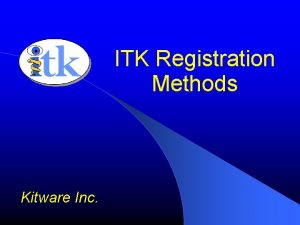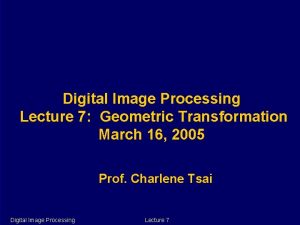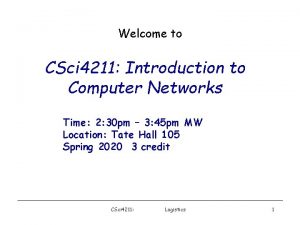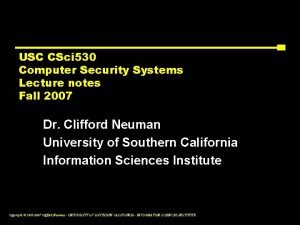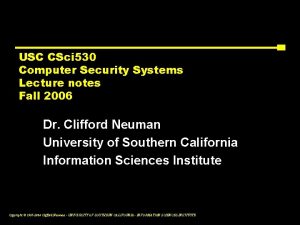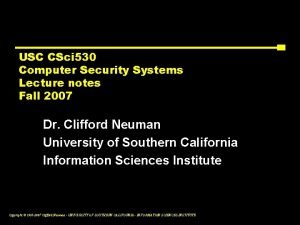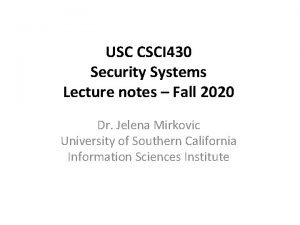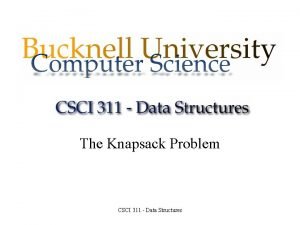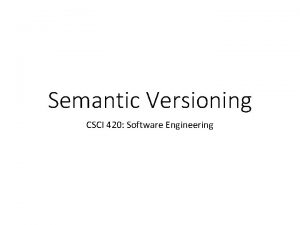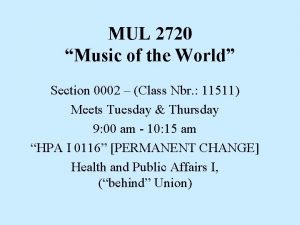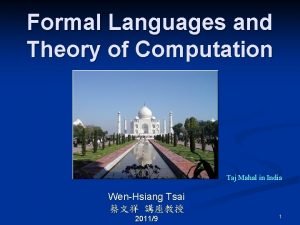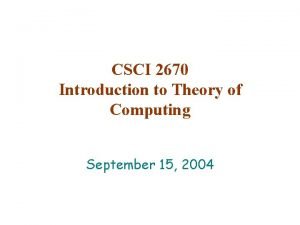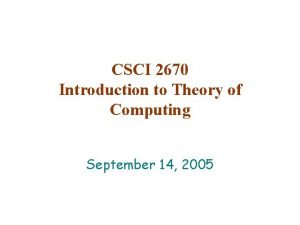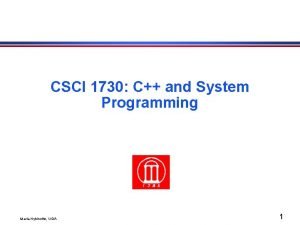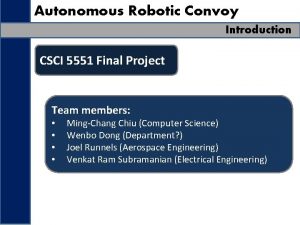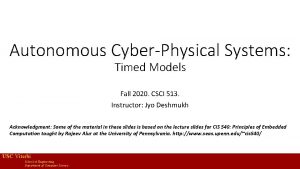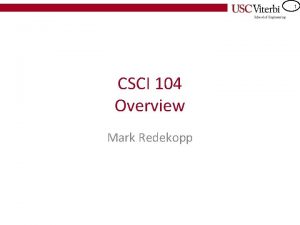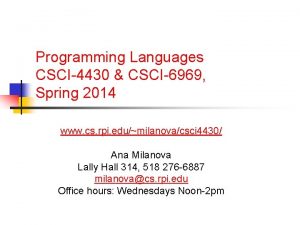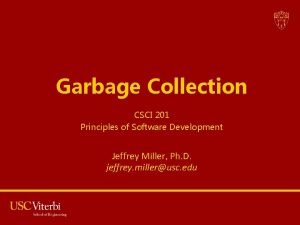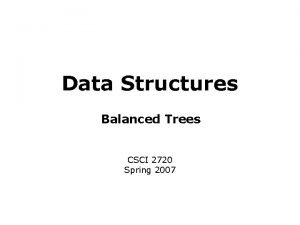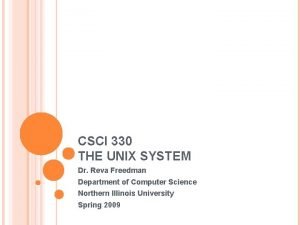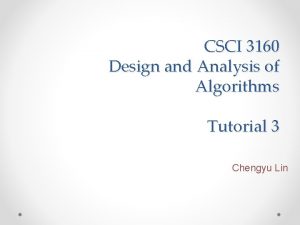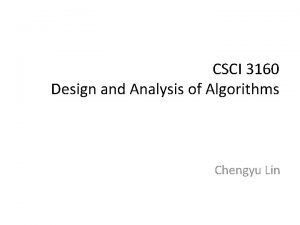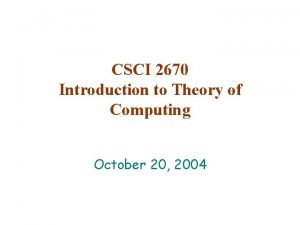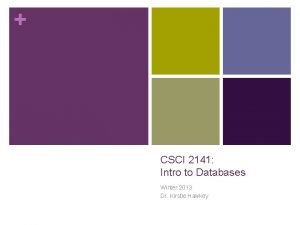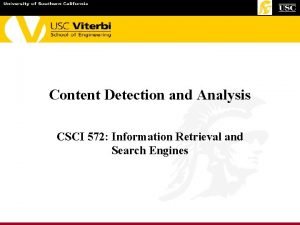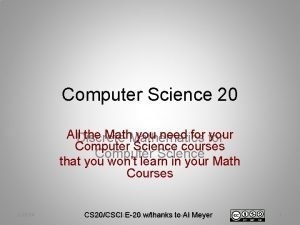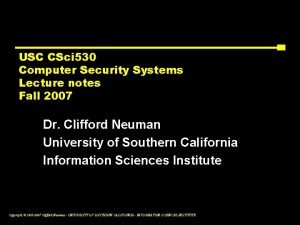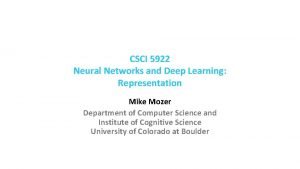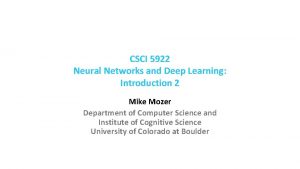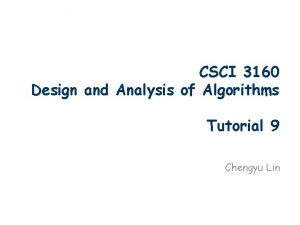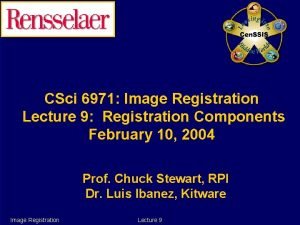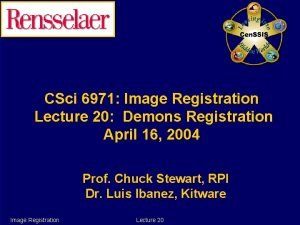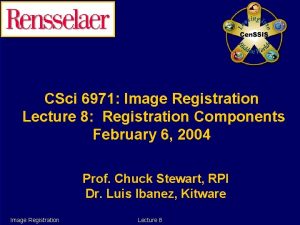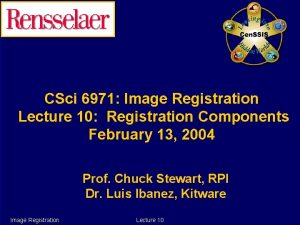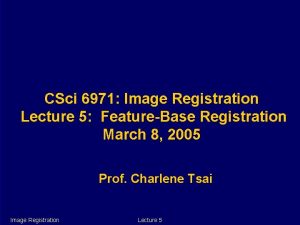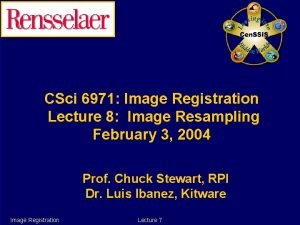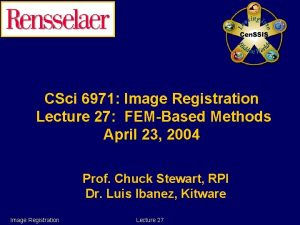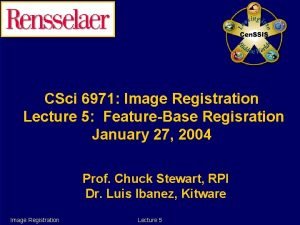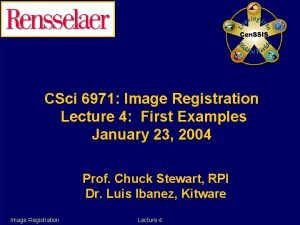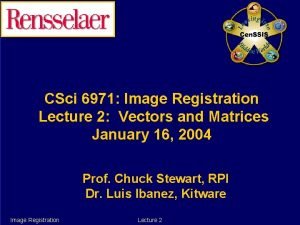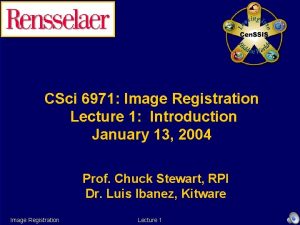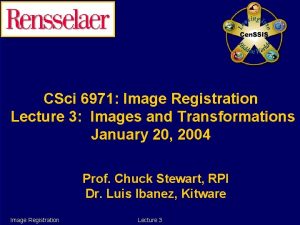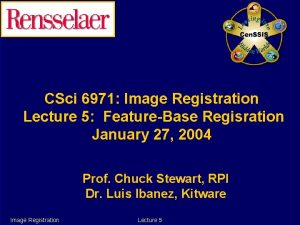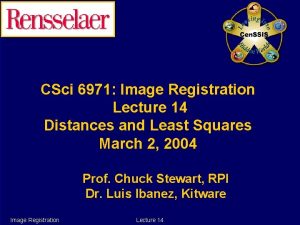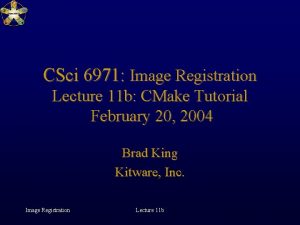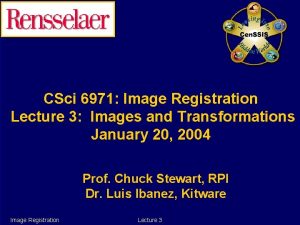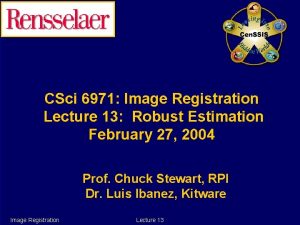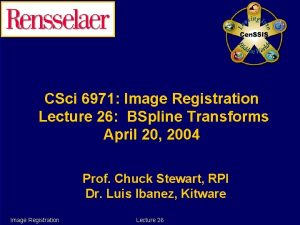CSci 6971 Image Registration Lecture 15 Data Structures
























![Example int main( int argc, char* argv[] ) { // …. //read in the Example int main( int argc, char* argv[] ) { // …. //read in the](https://slidetodoc.com/presentation_image/e7c318923e09eff8a4b1ef580a5c1cab/image-25.jpg)










- Slides: 35

CSci 6971: Image Registration Lecture 15: Data Structures & Other RGRL Features March 5, 2004 Prof. Chuck Stewart, RPI Dr. Luis Ibanez, Kitware Image Registration Lecture 15

Assignments Available § HW 7 § Programming project Image Registration Lecture 15 2

Outline § § Review the basic toolkit components Spatial data structures Range data example Other toolkit topics: § ROI § Initializer § Multiple stages (multiresolution) § Multiple feature types § Looking ahead to the rest of the semester Image Registration Lecture 15 3

Basic Components Representation objects § § § § rgrl_feature_set rgrl_scale rgrl_match_set rgrl_data_manager rgrl_transformation rgrl_converge_status Image Registration Compute objects § § § rgrl_matcher rgrl_weighter rgrl_scale_estimator rgrl_convergence_tester rgrl_feature_based_registration Lecture 15 4

Basic Loop § Input the moving and fixed feature sets and an initial estimate § Specify scale estimator, weighter, matcher and estimator § Loop § Compute matches (rgrl_matcher) § Estimate scale § Run IRLS with fixed scale § Re-estimate scale § Until converged Image Registration Lecture 15 5

Variations and Generalizations § § Mixes of feature types Multiple stages (resolutions) Multiple initial estimates View-based registration (after break) Image Registration Lecture 15 6

Spatial Data Structures § rgrl_feature_set includes 3 search member functions: § nearest_feature § features_within_distance § k_nearest_features § Naïve implementations of these functions would require O(N) search time for each “query” § Thus, we need spatial data structures to make these queries efficient. Three are used (vxl_src/contrib/rsdl) § Binning data structures (rsdl_bins and rsdl_bins_2 d) § Digital distance maps (rsdl_borgefors) § K-d trees (rsdl_kd_tree) Image Registration Lecture 15 7

Binning Data Structures § Divide rectangular region into rectangular bins § This is really just a coarse array § Feature point locations and associated values are stored in a list associated with the bin the location falls into Region searches: § Conducted by examining all bins that intersect the query region Nearest neighbor searches: § Spiral search starting at the bin containing the query point. § § Image Registration Lecture 15 8

Binning Data Structures § Advantages: § Simple and flexible § Insertions, queries and deletions are, on average, quite fast for sparse, scattered queries § Disadvantages: § Works poorly for clustered data Image Registration Lecture 15 9

Digital Distance Maps § Given: § Feature points organized as points along a series of contours § At each pixel in the image record: § Pointer to closet feature point § Distance to this feature point Image Registration Lecture 15 10

Digital Distance Maps § Computed in time proportional to the area of the image using digital distance approximations § Works well only with static data § Once the map is computed, only O(1) time is required to find the nearest point on the contour at each pixel Image Registration Lecture 15 11

k-d Tree § § Multi-dimensional analog to a binary search tree Partions region and partions data Recursive tree construction § Example shown in 2 d At each node of the tree § Find the dimension x or y, across which the data is most widely spread § Say this is x § § Find value of x, call it xm such that half the points have x values less than x. § Partition the data, assigning points with x < xm to the left subtree and the remaining points to the right Continue down the tree until each node has fewer than a small constant number of points Image Registration Lecture 15 Solid line shows root split Dashed line shows 1 st level splits Dotted line shows 2 nd level splits 12

k-d Tree Search § Region: § Recurse down the tree § At nodes completely contained inside the query region, gather all points § At nodes completely outside the query region, end this branch of the search § At nodes partially inside the query region, continue down each branch of the tree § c points nearest to a query point § Go down the tree until node is found containing the query point § Gather points, sorting them § Proceed back up (and perhaps down) the tree, gathering and inserting points until the nodes that must be added are further from the query than the current c-th point Image Registration Lecture 15 13

k-d Tree Discussion § Construction requires O(N log N) worst-case time and space § Queries require O(log n + c) on average, where c is the number of points “reported” (returned) § Worst-case is linear, but this does not happen in practice § Designed for static data, but can handle a small number of insertions and deletions Image Registration Lecture 15 14

Spatial Data Structures: Summary § rsdl_bins and rsdl_bins_2 d § Cache dynamic spatial information § Can’t handle cluttering § rsdl_borgefors § Represent static set of 2 d edge or contour points § O(1) access § rsdl_kd_tree § Multi-dimensional version of binary search tree § Static structure § Fast average case access, but slow worst-case § Potential research paper topic: § Data structures for registration Image Registration Lecture 15 15

Range Data Example § The famous Stanford Bunny § Points stored in k-d tree § Surface normals calculated by finding the c nearest points to each data point and fitting a planar surface Image Registration Lecture 15 16

Animation Image Registration Lecture 15 17

Advanced Properties of RGRL § Straightforward stuff (conceptually, at least) § Regions of Interest (ROIs) and masks § Initializers § Multiple stages § Multiple feature types § Feature extraction § More complicated stuff for after break § Initialization techniques § View-based registration Image Registration Lecture 15 18

ROIs and Masks § Mask (rgrl_mask): § Used to indicate which pixels in an image are currently “active” and to be used in an operation § In particular, you may want to register sections of images rather than entire images. § Subclasses implement: § Binary image mask § Rectilinear mask § Circular / spherical masks § ROI (rgrl_roi): § Rectangular region of interest or bounding box § Can be changed after being constructed § At some point these two should be combined Image Registration Lecture 15 19

Initializer (rgrl_initializer) § Provide initial information to the registration engines, including ROIs, estimator, initial estimates and initial scale § In examples thus far this information has been provided to the registration engine “by hand” § Provide multiple initial estimates § Test different initial estimates in attempt to obtain global convergence § Lectures 18 and 19 will discuss initialization techniques Image Registration Lecture 15 20

Multiple Stages § Thus far we’ve assumed registration has had a single stage § Although you might have used multiple stages in your solution to HW 6, Question 4 § Registration can proceed in multiple stages, however. § The solution to the registration problem at each stage is used to initialize registration at the next stage § Each stage contains § Moving and fixed feature sets § Matcher § Weighter § Xform estimators Image Registration Lecture 15 21

Multiple Stages (continued) § Information on stages need only be specified by § Constructing rgrl_data_manager with the single argument true § Calling rgrl_data_manager: : add_data for each stage, with stages indexed by 0, 1, etc. § The registration engine (rgrl_feature_based_registration) handles multiple stages automatically by receiving the initial stage index as an argument § Either from the initializer or directly to the run member function § The registration functions count down until stage 0 has completed Image Registration Lecture 15 22

Multiple Stages == Multiple Resolutions § Many registration techniques work first on coarser resolutions version of the images, extracting features at each resolution § Intuitively, we can think of resolutions and stages as the same thing § This requires (potentially) scaling the transformation and ROIs between resolutsion § This occurs if the feature-set is in image coordinates § BUT the notion of a stage is more general than resolution. Image Registration Lecture 15 23

Example § rgrl/examples/registration 3. cxx § Registration of multiresolution (2 resolutions) feature sets from a pair of retinal images § Most of the foregoing discussion is mirrored in this example Image Registration Lecture 15 24
![Example int main int argc char argv read in the Example int main( int argc, char* argv[] ) { // …. //read in the](https://slidetodoc.com/presentation_image/e7c318923e09eff8a4b1ef580a5c1cab/image-25.jpg)
Example int main( int argc, char* argv[] ) { // …. //read in the feature files // feature_vector moving_fps_high_res; feature_vector moving_fps_low_res; feature_vector fixed_fps_high_res; feature_vector fixed_fps_low_res; const char* fixed_file_name_high_res = argv[1]; const char* fixed_file_name_low_res = argv[2]; const char* moving_file_name_high_res = argv[3]; const char* moving_file_name_low_res = argv[4]; read_feature_file( moving_file_name_high_res, moving_fps_high_res ); read_feature_file( moving_file_name_low_res, moving_fps_low_res ); read_feature_file( fixed_file_name_high_res, fixed_fps_high_res ); read_feature_file( fixed_file_name_low_res, fixed_fps_low_res ); Image Registration Lecture 15

Example // Prepare feature sets // rgrl_feature_set_sptr moving_feature_set_high_res = new rgrl_feature_set_location<2>(moving_fps_high_res); rgrl_feature_set_sptr moving_feature_set_low_res = new rgrl_feature_set_location<2>(moving_fps_low_res); rgrl_feature_set_sptr fixed_feature_set_high_res = new rgrl_feature_set_location<2>(fixed_fps_high_res); rgrl_feature_set_sptr fixed_feature_set_low_res = new rgrl_feature_set_location<2>(fixed_fps_low_res); // Set the initial transformation to be identity // int dof = 6; //dof for affine model rgrl_transformation_sptr init_trans; vnl_matrix<double> A(2, 2, vnl_matrix_identity); vector_2 d t(0. 0, 0. 0); vnl_matrix<double> covariance_matrix( dof, 0. 0 ); init_trans = new rgrl_trans_affine(A, t, covariance_matrix); Image Registration Lecture 15

Example // We first instantiate the 2 transformation models, and the // initializer for the lower resolution. Please note, the // initializer has to have the knowledge of the resolution level at // which the registration begins. The higher the number is for the // resolution level, the lower the image resolution. The highest // resolution is always at the $0^{th}$ level. // rgrl_estimator_sptr affine_model = new rgrl_est_affine(6, 6); rgrl_estimator_sptr quadratic_model = new rgrl_est_quadratic(12, 12); vector_2 d x 0(0, 0); vector_2 d x 1(511, 511); rgrl_roi moving_image_region(x 0, x 1); rgrl_roi fixed_image_region(x 0, x 1); int initial_resolution = 1; rgrl_initializer_sptr initializer = new rgrl_initializer_prior(moving_image_region, fixed_image_region, affine_model, init_trans, initial_resolution ); Image Registration Lecture 15

Example // Create matcher // unsigned int k = 1; rgrl_matcher_sptr cp_matcher = new rgrl_matcher_k_nearest( k ); // Robust weighting // vcl_auto_ptr<rrel_m_est_obj> m_est_obj( new rrel_tukey_obj(4) ); rgrl_weighter_sptr wgter = new rgrl_weighter_m_est(m_est_obj, false); // Scale estimator both weighted and unweighted // int max_set_size = 3000; vcl_auto_ptr<rrel_objective> muset_obj( new rrel_muset_obj( max_set_size , false) ); rgrl_scale_estimator_unwgted_sptr unwgted_scale_est; rgrl_scale_estimator_wgted_sptr wgted_scale_est; unwgted_scale_est = new rgrl_scale_est_closest( muset_obj ); wgted_scale_est = new rgrl_scale_est_all_weights(); Image Registration Lecture 15

Example // Convergence tester // double tolerance = 1. 5; rgrl_convergence_tester_sptr conv_test = new rgrl_convergence_on_weighted_error( tolerance ); Image Registration Lecture 15

Example // We add data and appropriate models to both stages the same way as // we have done in the previous 2 examples. The only new step here // is to specify the transition going from the lower to the higher // resolution using // code{set_dimension_increase_for_next_stage()} method. This // method sets the parameter that allows the internal data to be // scaled properly when moving to the next resolution level. In this // example, since the lower resolution image is half the size for // each dimension of the original, the code{dimension_increase} is // set to 2 for the lower resolution. // bool multi_resol = true; rgrl_data_manager_sptr data = new rgrl_data_manager( multi_resol ); int resolution = 0; //original resolution data->add_data( resolution, moving_feature_set_high_res, fixed_feature_set_high_res, cp_matcher, wgter, unwgted_scale_est, wgted_scale_est ); data->add_estimator( resolution, quadratic_model); Image Registration Lecture 15

Example resolution = 1; //lower resolution double dimension_increase = 2; data->add_data( resolution, moving_feature_set_low_res, fixed_feature_set_low_res, cp_matcher, wgter, unwgted_scale_est, wgted_scale_est ); data->add_estimator( resolution, affine_model); data->set_dimension_increase_for_next_stage( resolution, dimension_increase); Image Registration Lecture 15

Example // Start the registration process // rgrl_feature_based_registration reg( data, conv_test ); reg. run( initializer ); // Output Results // … return 0; } Image Registration Lecture 15

Multiple Feature Sets at One Stage § We can also use simultaneous different types of features at a single stage § For example, vascular landmarks and trace points § Each feature set must have a different feature type § The rgrl_data_manager handles multiple feature sets automatically. § The registration objects automatically detect the existence of multiple feature sets: § It requests them from the data manager § It applies matching to them individually § It passes all matches to the estimation objects Image Registration Lecture 15 33

Feature Extraction § This far we have discussed little about feature extraction § This is unnecessary for range data § We have good algorithms for feature extraction in retinal images § Algorithms in vxl and itk can also be adapted to extract features Image Registration Lecture 15 34

After Break § Lecture 16: View-Based Registration § Lecture 17: Project / software discussion § Come to class prepared to work on projects and discuss the software § Lectures 18 -19: Initialization techniques § Lecture 20: Multiresolution § Lecture 21: Mutual information § Lectures 22 -24: Video sequences and mosaics § Lectures 25 -27: Deformable registration § Lecture 28: Project presentations Image Registration Lecture 15 35
 01:640:244 lecture notes - lecture 15: plat, idah, farad
01:640:244 lecture notes - lecture 15: plat, idah, farad Biology homology
Biology homology A survey of medical image registration
A survey of medical image registration Itk resample image filter
Itk resample image filter Image processing lecture notes
Image processing lecture notes Fluorocein
Fluorocein Csci 4211
Csci 4211 Csci 530
Csci 530 Csci 530
Csci 530 Csci 530 security systems
Csci 530 security systems Csci 430 usc
Csci 430 usc Csci 311
Csci 311 Csci 420
Csci 420 Scott warfield ucf
Scott warfield ucf Csci 1951a
Csci 1951a Csci 2670
Csci 2670 Csci 2670
Csci 2670 Hybinette
Hybinette Csci 5551
Csci 5551 Csci 513 usc
Csci 513 usc Csci 104
Csci 104 Csci 4430
Csci 4430 201 principles of software development
201 principles of software development Csci 2720
Csci 2720 Reva freedman
Reva freedman Csci 3160
Csci 3160 Csci 3160
Csci 3160 Csci 2670
Csci 2670 Csci 2141
Csci 2141 Csci572
Csci572 Csci e-20
Csci e-20 Csci 530 usc
Csci 530 usc Csci 5922
Csci 5922 Csci 5922
Csci 5922 Csci 3160
Csci 3160 Formal languages and automata theory tutorial
Formal languages and automata theory tutorial



